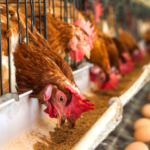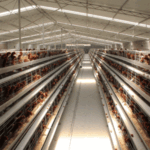The key points of summer chicken house ventilation technology
The hot weather has always been a serious challenge for the poultry industry. And it is sensitive to high temperature. The upper fatal body temperature is 45 degrees. The most suitable body temperature for chickens is 21 degrees. If the temperature is higher than this temperature, it will use part of the energy to release heat. As the body temperature rises, the chickens cannot fully eat, resulting in reduced production performance. In order to ensure that the chickens are not affected by the weather, the best way to cool down is to maintain good ventilation.
- Good thermal insulation layer
It is hot in summer, a pergola should be built on the roof of the chicken coop, which can reduce the temperature in the poultry chicken cages. The roof is painted white or covered with an insulating layer, which can reflect the sun’s heat radiation to the greatest extent and reduce the temperature in the house. It can also be used to spray water on the roof to reduce the temperature, which can reduce the temperature of the house by 2 to 3 ℃.
- Ensure the airtight of the chicken house
The airtight of the chicken house not only plays an important role in avoiding heat loss and saving energy in cold winter, but also plays a key role in summer ventilation. The airtight of the chicken house prevents the hot air from entering everywhere in summer, and prevents the air flow rate in the house from being reduced and affecting the cooling effect. If the airtight is not good, the efficiency of the fan will be reduced, and the negative pressure in the house will not meet the requirements, so that part of the air does not pass through the wet curtain and enters the chicken house, thereby reducing the cooling effect. Therefore, it should be ensured that there are no other places where the air enters except the air inlet. Pay special attention to the airtight of the door in the middle of the chicken house, the manure baffle, and the connection between the wet curtain and the chicken house.

- Maintain sufficient wind speed
It is recommended to keep the indoor temperature at 22-24°C in summer. When the temperature of the chicken house reaches 25°C, a longitudinal ventilation system should be used and more than half of the fans should be used. When the indoor temperature is higher than 27°C, the fan should be turned on and a wet curtain should be used to cool down. If the room temperature is higher than 32°C, all fans should be turned on. Care should be taken to ensure that the fan works effectively to provide maximum ventilation. Before use, make sure that the air inlet is fully opened, keep the fan and shutters in a clean state, and replace the worn fan belt and pulley in time to keep the belt tensioned and stretched at any time.
- Use wet curtain device
When the temperature difference between indoor and outdoor is large, the temperature is above 30 ℃, and the chickens have obvious thermal reaction, the temperature of the chicken house is still higher than 27 ℃ after all the fans in the house are started, and then the wet curtain is started to cool down, and the longitudinal ventilation system must be operated. Open the wet curtain after it is normal, and there should be no other air inlets except the air inlet of the wet curtain. When the fan and wet curtain are all turned on, and the house temperature is still above 30℃, add new water or ice to the reservoir and use spray to cool down to relieve; morning and evening and when the temperature drops below 27℃ or the relative humidity in the chicken house The wet curtain should be stopped when it exceeds 80%. It is generally recommended to turn on after 9 o’clock in the morning according to actual conditions, and it is recommended to close the wet curtain after 5 o’clock in the afternoon.
In short, farmers should correctly use poultry chicken farming equipment, rationally use and manage ventilation systems, and control temperature, relative humidity and wind speed at appropriate levels. Only in this way can we achieve the purpose of providing fresh air for the chicken coop, reducing the temperature difference and humidity, and reducing the dust and odor in the air. In order to avoid accidents such as ventilation system failures or power outages, all control systems should be regularly maintained and managed, and generators should be equipped.










